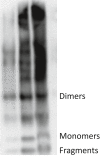Transthyretin amyloid deposits in lumbar spinal stenosis and assessment of signs of systemic amyloidosis
- PMID: 33274477
- PMCID: PMC8248398
- DOI: 10.1111/joim.13222
Transthyretin amyloid deposits in lumbar spinal stenosis and assessment of signs of systemic amyloidosis
Abstract
Background: Wild-type transthyretin (ATTRwt) amyloidosis is the most common systemic amyloidosis in Western countries and manifests mainly as progressive restrictive cardiomyopathy.
Objective: To study the prevalence of ATTR deposits in ligament tissue in patients undergoing surgery for lumbar spinal stenosis and to assess whether these deposits are associated with cardiac amyloidosis.
Materials and methods: A total of 250 patients, aged 50-89 (57% women), none with known cardiovascular disease, were included. Ligaments were investigated microscopically for amyloid. ATTR type was determined by immunohistochemistry and fibril type by Western blot. The amount of amyloid was graded 0-4. All patients with grade 3-4 ATTR deposits were offered cardiac investigation including ECG, cardiac ultrasound, plasma NT-proBNP and cardiac magnetic resonance (CMR), including modern tissue characterization.
Results: Amyloid was identified in 221 of the samples (88.4%). ATTR appeared in 93 samples (37%) of whom 42 (17 women and 25 men) were graded 3-4; all had fibril type A (mixture of full-length TTR and fragmented TTR). Twenty-nine of 42 patients with grade 3-4 ATTR deposits accepted cardiovascular investigations; none of them had definite signs of cardiac amyloidosis, but five men had a history of carpal tunnel syndrome.
Conclusions: The prevalence of ATTR deposits in ligamentum flavum in patients with lumbar spinal stenosis was high but not associated with manifest ATTR cardiac amyloidosis. However, the findings of fibril type A, the prevalence of previous carpal tunnel syndrome and ATTR amyloid in surrounding adipose and vascular tissue indicate that amyloid deposits in ligamentum flavum may be an early manifestation of systemic ATTR disease.
Keywords: ATTR amyloidosis; Lumbar spinal stenosis; cardiac amyloidosis; magnetic resonance imaging; systemic amyloidosis.
© 2020 The Authors. Journal of Internal Medicine published by John Wiley & Sons Ltd on behalf of Association for Publication of The Journal of Internal Medicine.
Conflict of interest statement
Dr. Eldhagen reports grants and personal fees from Pfizer, personal fees from Alnylam, Orion Pharma and Sanofi, outside the submitted work. Dr. Lund reports personal fees from Merck, Sanofi, Bayer, Pharmacosmos, Abbott, Medscape and MyoKardia; grants and personal fees from Vifor‐Fresenius, AstraZeneca, Relypsa, Mundipharma, Boehringer Ingelheim and Novartis; and grants from Boston Scientific, outside the submitted work. Dr. Suhr reports nonfinancial support and other from Pfizer Pharmaceuticals, Prothena Pharmaceuticals, Alnylam Pharmaceuticals and Akcea Pharmaceuticals and other from Eidos Therapeutics, Inc, and Intellia Pharmaceuticals, outside the submitted work. Dr. Westermark reports personal fees and research grants from Pfizer and Alnylam. Dr. Berg and Dr. Sörensson have nothing to disclose.
Figures







References
-
- Benson MD, Buxbaum JN, Eisenberg DS et al. Amyloid nomenclature 2018: recommendations by the International Society of Amyloidosis (ISA) Nomenclature Committee. Amyloid 2018; 25: 215–9. - PubMed
-
- Rowczenio DM, Noor I, Gillmore JD et al. Online registry for mutations in hereditary amyloidosis including nomenclature recommendations. Hum Mutat 2014; 35: E2403–E12. - PubMed
-
- Gustavsson Å, Jahr H, Tobiassen R et al. Amyloid fibril composition and transthyretin gene structure in senile systemic amyloidosis. Lab Invest 1995; 73: 703–8. - PubMed
-
- Foss TR, Wiseman RL, Kelly JW. The pathway by which the tetrameric protein transthyretin dissociates. Biochemistry 2005; 44: 15525–33. - PubMed
Publication types
MeSH terms
Substances
LinkOut - more resources
Full Text Sources
Other Literature Sources
Medical
Research Materials
Miscellaneous

